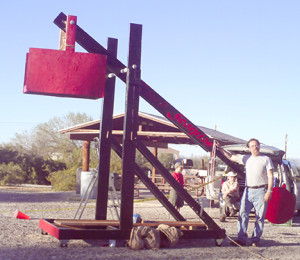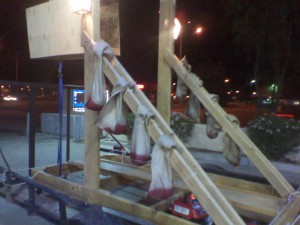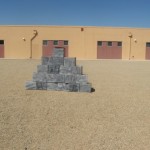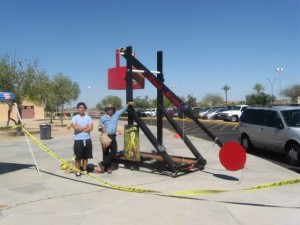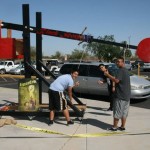The Black Scorpion: Modular Trebuchet
This Trebuchet is constructed to have a maximum counterweight of 700 pounds, though we have never placed more than 300 lbs in the box. Our unit can hurl an 8 lb projectile approximately 135 feet (41 meters), and a 5 lb projectile 150 feet (45 meters). While respectable, it is no champion.
While many choose to hurl pumpkins, melons, and other “explosive” projectiles, we were concerned about the mess that could be left behind while we were targeting less remote sites for our events … like parking lots.
We shoot Zombie heads. A Zombie head is a balloon filled with water to the desired weight, and placed in a burlap bag. Easy to make, load, fire, and gives a very satisfyingly visual and auditory splat upon impact. Best of all … easy clean-up by picking up the burlap bags afterwards. The bag is easy to spot and retrieve, and the bag contains the plastic of the balloon. Best of all, the bags are reuseable! Additional considerations are that the bags, “ammo” can be hung on hooks on the braces to make re-loading a snap.
And, of course, what trebuchet would be complete without a castle to hurl at? Using cardboard boxes painted with black and grey, we created a stackable wall to shoot at.
Hurling
During testing, we used two 50 pound bags of river rock. These come in a plastic bag that is tough enough to be carried and stacked many times. Two bags gave us 100 pounds on the counter weight for swing-testing. During testing, we gradually increased our weight in 50 pound increments. At 300 pounds it required three people to pull the arm down, and at 400 pounds the three of us struggled to bring it down, so a winch was added.
For the events that we visit, we set up a 200 foot long range, to a width of 100 feet. Caution tape is ringed around the trebuchet firing area for 20 feet, and and additional 50 feet bordering the target range. Our trigger line is 50 feet long to allow visitors to release the projectile safely.
Our standard load on the counterweight is 300 lbs, and can be operated by a single individual during loading and firing. The winch includes a locking pawl for safety, that allows the sling to be loaded and positioned. Once locked with the trigger, a simple double eybolt and pin setup, the winch is disenaged for firing.
The motion of the trebuchet during firing is almost more interesting than the distance it can throw, given the seemingly-slow movement through its arc. This seductive smoothness is easily discounted as the projectile leaves the sling and the arm swings back and forth, violently rolling the assembly back and forth.
During testing, we found that when the trebuchet frame was placed flat on the ground, it would buck furiously during the firing arc, that made targeting problematic. Once the casters were added, the bucking ceased. Now, the entire assembly rolls back and forth, nearly 4 feet during firing, and the after-swing. Additionally, the casters smooth out the movement, improving the consistency our targeting.
Design
In designing the hurler, my goals were straightforward:
- small storage footprint,
- ease of transport,
- one-man setup/takedown,
- the ability to demonstrate the seige weapon effectively and safely.
The footprint of the base frame is 4′ wide by 8′ long. The frame is screwed together with three inch screws, with corner buttresses for additional strengthening.
Component Parts:
- The base frame, 4′ x 8′ frame, with casters.
- Two (2) 10′ posts
- Two (2) 8′ angle braces, with two support-spacer blocks, one has a hand-crank winch affixed.
- The counterweight box is a two sided, u-shaped 2′ x 4′ box, designed to hold multiple 50 pound bags of sand or river rock.
- The arm is composed of two pieces. The extensor slides into the base arm and bolted in place to give us a full 16 foot long arm.
- Arm axle, made from 4-1/2′ long 1″ galvanized steel pipe, typically used for electrical conduit, with screw end caps
- Counterweight axle, also made from 1″ galvanized steel pipe, is 28″ long, also with screw end caps.
Assembly is accomplished as follows:
- Place the base frame
- Place the posts in their slide-in slots, and bolt into place
- Position angle braces, and bolt into place, top and bottom with spacer blocks
- Insert Arm Axle through one post, half way across to other post
- Slide Arm-Base onto axle, and then slide axle into other post, anchoring with end caps
- Tip Arm-Base, and slide Arm-Extensor in until it stops, bolting in place
- Connect sling to Extensor
- Set Counter weight box into position at front, and pull short end of arm down to align for Counter-weight-axle
- Insert Counter-weight-axle, and secure with endcaps
- Add sand/rock bags to desired counter weight.
- Load and fire.
A single person can assemble the trebuchet in 45 minutes or less, while a team can accomplish full setup in 30 minutes or less. Perhaps the most difficult aspect of the assembly is the placement of the Arm-Base on the axle. It is heavy and awkward, not to mention stressful. This is the most hazardous part of assembly, and a second, (or third) person makes the job much easier.
Our best setup time was approximately 20 minutes. Take down times are similar.
Transport
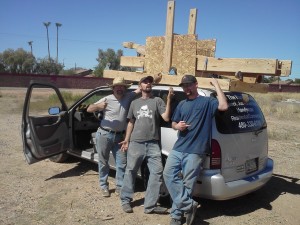 Transporting the trebuchet from point to point was a factor in its design. I did not wish to have to store a trailer, as well as the trebuchet. So the modular design was crucial. I currently carry most of the parts inside my van, and the frame and counter weight box on top. With care, I can successfully load and unload everything myself in about 30 minutes.
Transporting the trebuchet from point to point was a factor in its design. I did not wish to have to store a trailer, as well as the trebuchet. So the modular design was crucial. I currently carry most of the parts inside my van, and the frame and counter weight box on top. With care, I can successfully load and unload everything myself in about 30 minutes.
Storage
Once dissassembled, the trebuchet components occupy just 8 linear feet of wall space, 3′ deep, standing 10′ tall.
Current Status
The Black Scorpion’s arm was found to have warped at our last event causing a wide left-right swing in the arm during the dry-fire test launch. As a safety precaution, it was not used during the event.
Currently, I am redesiging the arm for a relaunch later this fall.
